Learning the friendly way
Dive into our resources, guides, and articles for all things money-related. Grow your financial confidence with our experts curated tips and articles for both experienced and new investors.
LATEST ARTICLEs

2025 has been a defining year for AI. OpenAI’s GPT-5 and Anthropic’s Claude Sonnet 4.5 have raised the bar once again, each one aiming to blend stronger reasoning, longer memory, and more autonomy into one seamless system. Both are built to handle coding, research, writing, and enterprise-scale tasks, yet their design philosophies differ sharply.
This breakdown explores how the two stack up across performance, reasoning, coding, math, efficiency, and cost, helping users and teams decide where each model truly shines.
A Quick Overview
Claude Sonnet 4.5 builds on Anthropic’s refined Claude family. It extends memory across sessions, handles million-token contexts via Amazon Bedrock and Vertex AI, and features smart context management that prevents sudden cut-offs. It can run autonomously for 30 hours on extended tasks, making it ideal for ongoing workflows.
Meanwhile, GPT-5 is OpenAI’s flagship successor to GPT-4, tuned for agentic reasoning, where the model plans, executes, and coordinates tools on its own. Its adaptive reasoning system dynamically chooses between shallow or deep “thinking” paths, letting users balance speed, cost, and depth per task. GPT-5 also offers specialized variants (Mini, Nano) for lighter workloads.
Reasoning and Analysis
Both models far exceed their 2024 counterparts, but they differ in how they reason.
GPT-5’s deep-reasoning mode significantly boosts performance in multi-step logic, scientific, and spatial tasks. It can break problems into chains, test sub-hypotheses, and self-correct mid-process. However, disabling this mode reduces accuracy sharply, it can be brilliant when “thinking deeply,” but more variable when not.
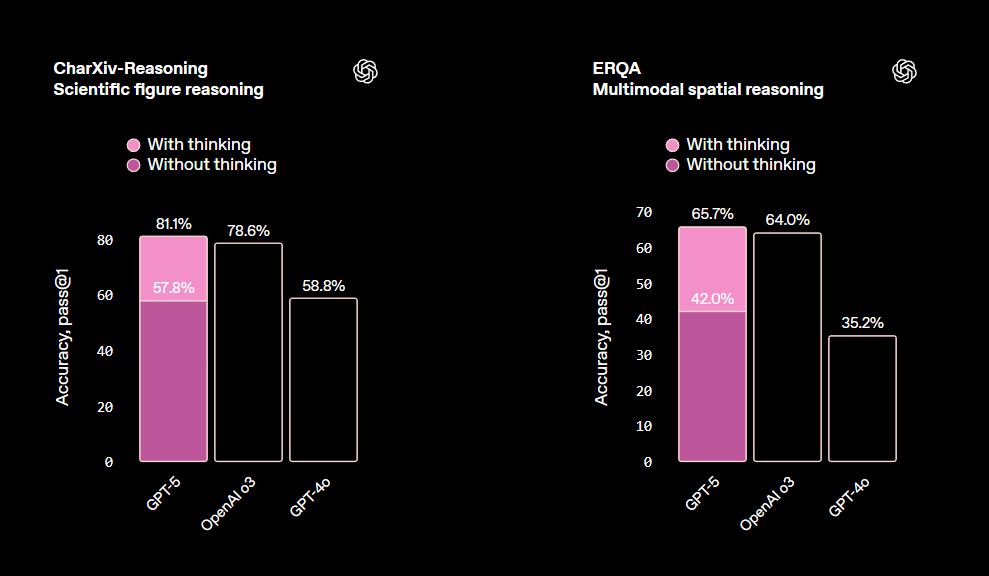
Claude Sonnet 4.5, by contrast, stays stable even without added configuration. It’s particularly strong in financial, policy, and business logic, where structure and coherence matter more than creative leaps. For enterprise Q&A or decision support, that predictability is valuable.

If you want an AI that reasons steadily, Claude takes the lead. If you need exploratory logic (i.e. complex hypothesis testing or cross-domain synthesis) GPT-5’s deeper path is unmatched.
Math and Structured Problem Solving
As seen in the benchmarks provided by Anthropic, Claude Sonnet 4.5 continues its consistency streak. Whether calculating directly or using Python tools, it achieves top-tier math accuracy. This means it handles structured logic even in constrained environments.
GPT-5 also reaches near-perfect accuracy, but only when tool use and reasoning depth are active. Disable them, and results drop noticeably. It relies heavily on its reasoning pipeline to stay sharp.
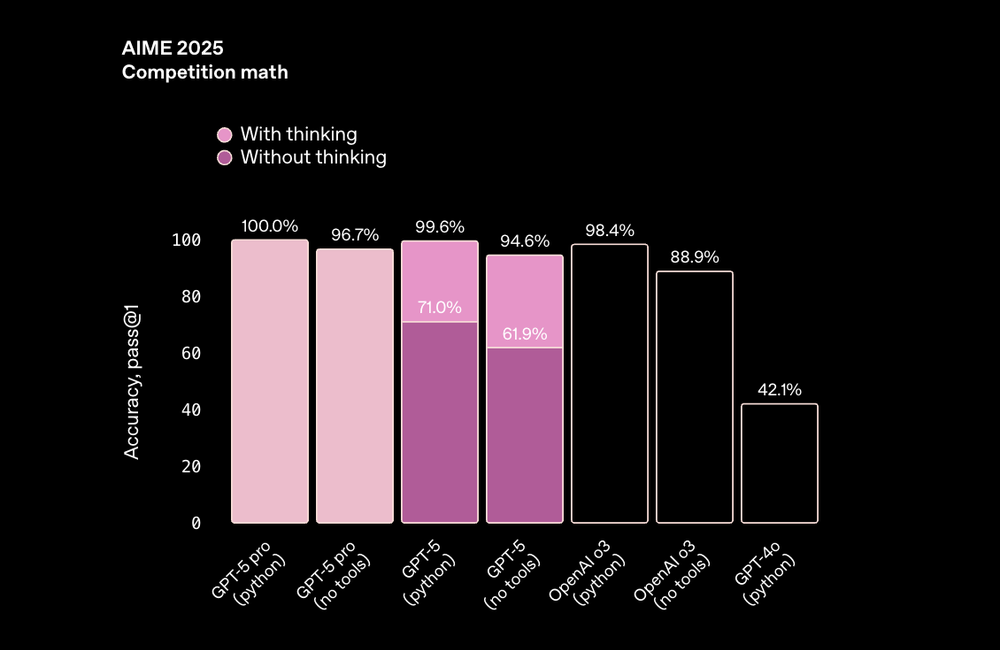
Verdict:
- Claude Sonnet 4.5: dependable out-of-the-box math solver.
- GPT-5: flexible but needs tuning to perform at its best.
Coding and Software Engineering
When it comes to coding, the two models diverge in style.
Claude Sonnet 4.5 delivers stable performance without special tuning. In tests resembling HumanEval+ and MBPP+, it maintains high accuracy across conditions, making it dependable for production pipelines. Its strength lies in consistency, results rarely fluctuate, which is crucial for enterprise use.

By contrast, GPT-5 achieves higher peak scores when its advanced reasoning is enabled, especially in multi-language or large-project contexts. In JavaScript and Python refactoring tasks, for instance, it outperformed Sonnet when its “high-reasoning” mode was active — though baseline runs without that mode varied more.
For agentic coding, where the AI calls external tools or terminals, Sonnet 4.5 often executes with fewer dropped commands. GPT-5, on the other hand, can chain more tool calls simultaneously, making it better for complex orchestration, provided you configure it carefully.
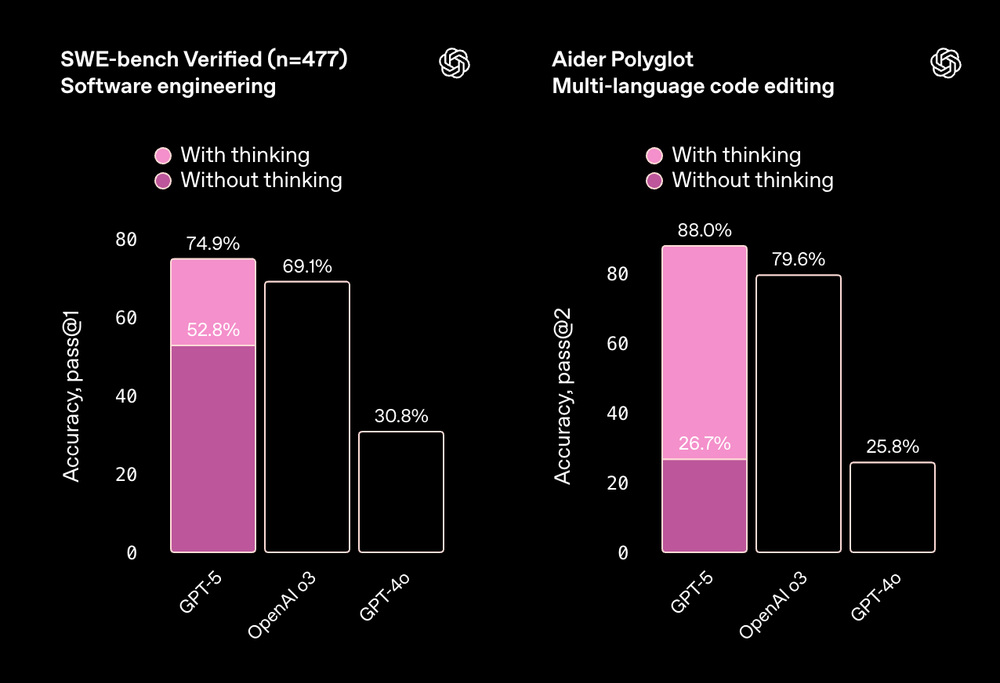
Verdict:
- Claude Sonnet 4.5: predictable, steady engineering partner.
- GPT-5: versatile powerhouse, but performance hinges on setup.
Cost and Efficiency
GPT-5 is clearly cheaper per token, particularly for large inputs. Its adaptive router also saves compute by running simple prompts on lighter paths.
Claude Sonnet 4.5 charges more but maintains predictable latency, a key factor for production environments that value reliability over marginal savings. For very large prompts, its cost rises faster than GPT-5’s, though batch discounts narrow the gap.
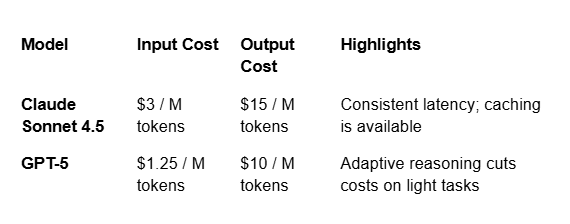
TL;DR: GPT-5 wins on price and scalability, whereas Claude wins on timing consistency and stability.
Pricing for Premium Plans
Beyond API access, both OpenAI and Anthropic offer premium subscriptions for individual users, which differ in features and pricing.
ChatGPT Plus, powered by GPT-5, is priced at $20 per month, giving users priority access to GPT-5, faster response times, and early access to new features and memory. OpenAI’s unified ChatGPT experience also includes file uploads, image generation, and custom GPTs.
Claude Pro, meanwhile, costs $20 per month as well and grants access to Claude Sonnet 4.5, offering faster responses, higher rate limits, and longer context windows. While it lacks built-in multimodal tools, Claude focuses on text clarity and structured reasoning, appealing to researchers, analysts, and writers seeking dependability over versatility.
TL;DR: both Plus plans are tied in price; what sets them apart, however, is their offering.
Different Strengths for Different Needs
It’s tempting to crown one “best,” but GPT-5 and Claude Sonnet 4.5 serve different priorities for different users and teams.
- Claude Sonnet 4.5: best for reliability and sustained performance. If you want consistent outputs and clear memory behavior, Claude delivers.
- GPT-5: best for depth, flexibility, and scalability. When configured properly, it surpasses rivals in creative reasoning, multimodal integration, and adaptive tool use.
Most teams may find the strongest setup is multi-model, using Claude where consistency matters most, and GPT-5 for data-intensive workflows.
Ultimately, these aren’t just chatbots anymore, they’re full-fledged digital collaborators, each with distinct personalities. Claude Sonnet 4.5 is your calm, methodical analyst. GPT-5 is your ambitious polymath. Which one you pick depends less on their individual benchmarks and more on your mission.

Το Tap είναι μια fintech πλατφόρμα που συνδυάζει την παραδοσιακή τράπεζα με το κρυπτονόμισμα. Λανσαρίστηκε το 2019 και προσφέρει ένα ευρύ φάσμα χρηματοοικονομικών εργαλείων και χαρακτηριστικών. Το token XTP ξεκλειδώνει premium υπηρεσίες και ανταμοιβές, ενισχύοντας περαιτέρω την εμπειρία με το Tap.
Το Tap (XTP) είναι μια πρωτοποριακή χρηματοοικονομική τεχνολογική πλατφόρμα που ιδρύθηκε το 2019, επαναστατώντας στον τομέα των οικονομικών με τη σύγκλιση της παραδοσιακής τράπεζας και της διαχείρισης κρυπτονομισμάτων. Διευκολύνει άμεσες, δωρεάν χρηματικές μεταφορές εντός του δικτύου της, ανταμείβοντας την κοινότητά της και απλοποιώντας το διαχωρισμό λογαριασμών και τον επιμερισμό εξόδων. Το Tap στοχεύει στη δημοκρατικοποίηση των οικονομικών και στην ενδυνάμωση των ατόμων με ολοκληρωμένα χρηματοοικονομικά εργαλεία, προσφέροντας εύχρηστες διεπαφές, ισχυρά χαρακτηριστικά και ισχυρά μέτρα ασφαλείας.
Τι είναι το Tap - Παρουσίαση της Λειτουργικότητας του Tap
Το Tap είναι μια ολοκληρωμένη οικονομική πλατφόρμα που συνδυάζει αρμονικά παραδοσιακούς λογαριασμούς χρημάτων και διαχείριση κρυπτονομισμάτων, παρέχοντας στους χρήστες μια κεντρική πλατφόρμα για όλες τις χρηματικές τους συναλλαγές. Στον πυρήνα της βρίσκεται μια εφαρμογή για κινητά που λειτουργεί ως η κύρια διεπαφή για την πρόσβαση στις υπηρεσίες του Tap.
Πριν αποκτήσουν πρόσβαση, οι χρήστες πρέπει να υποβληθούν σε μια διαδικασία επαλήθευσης που περιλαμβάνει την παροχή προσωπικών πληροφοριών για τη συμμόρφωση με τους κανονισμούς Γνώρισε τον Πελάτη σου (KYC) και Καταπολέμησης της Νομιμοποίησης Εσόδων από Παράνομες Δραστηριότητες (AML). Μόλις επαληθευτούν, η φιλική προς το χρήστη εφαρμογή τους επιτρέπει να αγοράζουν, να πωλούν και να αποθηκεύουν με ασφάλεια ένα ευρύ φάσμα κρυπτονομισμάτων - επί του παρόντος σχεδόν 50 διαφορετικές επιλογές.
Η εφαρμογή απλοποιεί τη διαδικασία απόκτησης κρυπτονομισμάτων, αποδεχόμενη διάφορους τρόπους πληρωμής, συμπεριλαμβανομένων χρεωστικών καρτών και τραπεζικών μεταφορών. Οι χρήστες μπορούν επίσης να μεταφέρουν κρυπτονομίσματα από τα εξωτερικά τους πορτοφόλια στον λογαριασμό τους στο Tap ή να πωλήσουν τα αποθέματά τους και να μεταφέρουν συμβατικό νόμισμα απευθείας στους τραπεζικούς τους λογαριασμούς. Εναλλακτικά, οι χρήστες μπορούν επίσης να στείλουν κρυπτονομίσματα σε άλλα πορτοφόλια ή ανταλλακτήρια. Το σύστημα πορτοφολιού του Tap είναι σχεδιασμένο με ισχυρά μέτρα ασφαλείας και δυνατότητες κρυπτογράφησης, διασφαλίζοντας την ασφαλή φύλαξη των περιουσιακών στοιχείων των χρηστών.
Για την απρόσκοπτη δαπάνη κρυπτονομισμάτων, οι χρήστες μπορούν να παραγγείλουν μια κάρτα Tap Mastercard – διαθέσιμη τόσο σε φυσική όσο και σε εικονική μορφή – απευθείας μέσω της εφαρμογής. Για να χρησιμοποιήσουν την κάρτα για αγορές, μπορούν να την προφορτώσουν απευθείας από το πορτοφόλι Tap. Η κάρτα επιτρέπει επίσης αναλήψεις μετρητών από ΑΤΜ παγκοσμίως και προσφέρει γενναιόδωρο Cashback έως και 8%, ανάλογα με το επίπεδο του χρήστη. Επιπλέον, η κάρτα παρέχει εξαιρετικές συναλλαγματικές ισοτιμίες, επιτρέποντας στους χρήστες της να ξοδεύουν παγκοσμίως χωρίς ανησυχία.
Tap - Παρουσίαση της Λειτουργικότητας του Tap
Το Tap είναι μια ολοκληρωμένη οικονομική πλατφόρμα που συνδυάζει αρμονικά παραδοσιακούς λογαριασμούς χρημάτων και διαχείριση κρυπτονομισμάτων, παρέχοντας στους χρήστες μια κεντρική πλατφόρμα για όλες τις χρηματικές τους συναλλαγές. Στον πυρήνα της βρίσκεται μια εφαρμογή για κινητά που λειτουργεί ως η κύρια διεπαφή για την πρόσβαση στις υπηρεσίες του Tap.
Πριν αποκτήσουν πρόσβαση, οι χρήστες πρέπει να υποβληθούν σε μια διαδικασία επαλήθευσης που περιλαμβάνει την παροχή προσωπικών πληροφοριών για τη συμμόρφωση με τους κανονισμούς Γνώρισε τον Πελάτη σου (KYC) και Καταπολέμησης της Νομιμοποίησης Εσόδων από Παράνομες Δραστηριότητες (AML). Μόλις επαληθευτούν, η φιλική προς το χρήστη εφαρμογή τους επιτρέπει να αγοράζουν, να πωλούν και να αποθηκεύουν με ασφάλεια ένα ευρύ φάσμα κρυπτονομισμάτων - επί του παρόντος σχεδόν 50 διαφορετικές επιλογές.
Η εφαρμογή απλοποιεί τη διαδικασία απόκτησης κρυπτονομισμάτων αποδεχόμενη διάφορες μεθόδους πληρωμής, συμπεριλαμβανομένων χρεωστικών καρτών και τραπεζικών μεταφορών. Οι χρήστες μπορούν επίσης να μεταφέρουν κρυπτονομίσματα από τα εξωτερικά τους πορτοφόλια στον λογαριασμό τους στο Tap ή να πωλήσουν τα αποθέματά τους και να μεταφέρουν συμβατικό νόμισμα απευθείας στους τραπεζικούς τους λογαριασμούς. Εναλλακτικά, οι χρήστες μπορούν επίσης να στείλουν κρυπτονομίσματα σε άλλα πορτοφόλια ή ανταλλακτήρια. Το σύστημα πορτοφολιού του Tap είναι σχεδιασμένο με ισχυρά μέτρα ασφαλείας και δυνατότητες κρυπτογράφησης, διασφαλίζοντας την ασφαλή φύλαξη των περιουσιακών στοιχείων των χρηστών.
Για απρόσκοπτη δαπάνη κρυπτονομισμάτων, οι χρήστες μπορούν να παραγγείλουν μια κάρτα Tap Mastercard - διαθέσιμη τόσο σε φυσική όσο και σε εικονική μορφή - απευθείας μέσω της εφαρμογής. Για να χρησιμοποιήσουν την κάρτα για αγορές, μπορούν να την προφορτώσουν απευθείας από το πορτοφόλι τους στο Tap. Η κάρτα επιτρέπει επίσης αναλήψεις μετρητών από ΑΤΜ παγκοσμίως και προσφέρει γενναιόδωρη επιστροφή μετρητών έως και 8%, ανάλογα με το επίπεδο του χρήστη. Επιπλέον, η κάρτα παρέχει εξαιρετικές συναλλαγματικές ισοτιμίες, επιτρέποντας στους χρήστες της να ξοδεύουν παγκοσμίως χωρίς ανησυχία.
Τι κάνει το Tap μοναδικό;
Ξεχάστε το ζογκλάρισμα πολλαπλών εφαρμογών και λογαριασμών. Το Tap συνδυάζει αρμονικά παραδοσιακούς λογαριασμούς χρημάτων με πρωτοποριακά κρυπτονομίσματα, όλα σε μία διαισθητική πλατφόρμα. Μετατρέψτε άμεσα τα ψηφιακά σας περιουσιακά στοιχεία σε μετρητά για καθημερινή χρήση ή αναπτύξτε το χαρτοφυλάκιό σας με ένα ευρύ φάσμα υποστηριζόμενων κρυπτονομισμάτων. Είναι ο καλύτερος συνδυασμός και των δύο κόσμων.
Αυτό που πραγματικά ξεχωρίζει το Tap είναι η ικανότητά του να μετατρέπει άμεσα κρυπτονομίσματα σε συμβατικό νόμισμα με τη λειτουργία on-off ramp. Τέλος στις αναμονές και τις περίπλοκες διαδικασίες. Αυτή η λειτουργία είναι ιδιαίτερα χρήσιμη για χρήστες που θέλουν να ενσωματώσουν κρυπτονομίσματα στις καθημερινές τους συναλλαγές, καθώς εξαλείφει τη συνήθη καθυστέρηση που σχετίζεται με τις μετατροπές από κρυπτονομίσματα σε συμβατικό νόμισμα.
Η υποστήριξη ενός ευρέος φάσματος κρυπτονομισμάτων από το Tap παρέχει στους χρήστες την ευελιξία να αποθηκεύουν, να διαχειρίζονται και να συναλλάσσονται ένα διαφοροποιημένο χαρτοφυλάκιο, όλα από μία πλατφόρμα. Αυτή η ευρεία υποστήριξη το καθιστά μια κορυφαία εφαρμογή για τους ενθουσιώδεις των κρυπτονομισμάτων.
Τι είναι το Οικοσύστημα του Tap;
Το οικοσύστημα του Tap ενσωματώνει ένα ολοκληρωμένο σύνολο χρηματοοικονομικών υπηρεσιών και λειτουργιών που στοχεύουν στην παροχή μιας απρόσκοπτης διεπαφής για την παρακολούθηση τόσο των κατατεθειμένων όσο και των κρυπτοπεριουσιακών στοιχείων.
Ακολουθεί μια λίστα με τις διάφορες λειτουργίες που προσφέρει:
Πορτοφόλι Πολλαπλών Νομισμάτων:
Το Tap προσφέρει ένα ασφαλές και κρυπτογραφημένο ψηφιακό πορτοφόλι που υποστηρίζει πάνω από 50 διαφορετικά κρυπτονομίσματα. Αυτό το πορτοφόλι επιτρέπει στους χρήστες να αποθηκεύουν, διαχειρίζονται και να εναλλάσσονται εύκολα μεταξύ διαφόρων κρυπτονομισμάτων και νομισμάτων fiat, καλύπτοντας τόσο τις επενδυτικές όσο και τις καθημερινές συναλλακτικές ανάγκες.
Ανταλλαγή Κρυπτονομισμάτων:
Οι χρήστες μπορούν να συναλλάσσονται σε ένα ευρύ και διαφοροποιημένο φάσμα κρυπτονομισμάτων. Σε αντίθεση με άλλες πλατφόρμες με περιορισμένα ζεύγη, το Tap επιτρέπει στους χρήστες να ανταλλάσσουν οποιοδήποτε περιουσιακό στοιχείο με οποιοδήποτε άλλο χωρίς περιορισμούς. Αυτή η απλή διαδικασία διασφαλίζει την ευελιξία και την ευκολία χρήσης. Επιπλέον, η πλατφόρμα συναλλαγών δίνει προτεραιότητα στην ταχύτητα και την αποτελεσματικότητα, προσφέροντας μια αξιόπιστη και φιλική προς το χρήστη εμπειρία σε όλους τους χρήστες.
Η Κάρτα Tap:
Ένα καίριο στοιχείο του οικοσυστήματος Tap είναι η προπληρωμένη Mastercard, η οποία δίνει τη δυνατότητα στους χρήστες να ξοδεύουν και να αποσύρουν χρήματα παγκοσμίως.
Επιστροφή Μετρητών:
Ένα ξεχωριστό χαρακτηριστικό των προσφορών του Tap είναι το πρόγραμμα επιστροφής μετρητών, που παρέχει ανταμοιβές σε όλους τους χρήστες που χρησιμοποιούν την κάρτα τους. Αναβαθμίζοντας, οι χρήστες μπορούν να ξεκλειδώσουν ακόμη περισσότερα οφέλη, κερδίζοντας έως και 8% επιστροφή μετρητών στις αγορές με την κάρτα Tap.
Άμεσες Μεταφορές Χρημάτων:
Το Tap επιτρέπει γρήγορες και δωρεάν μεταφορές χρημάτων παγκοσμίως μέσω του δικτύου Tap2Tap, επιτρέποντας στους χρήστες να στέλνουν κρυπτονομίσματα σε άλλους χρήστες Tap μέσα στην εφαρμογή χωρίς επιπλέον χρεώσεις.
Υποστήριξη Νομισμάτων Fiat:
Παράλληλα με τις υπηρεσίες κρυπτονομισμάτων, το Tap υποστηρίζει επίσης διάφορα νομίσματα fiat, επιτρέποντας στους χρήστες να διαχειρίζονται παραδοσιακά νομίσματα παράλληλα με τα ψηφιακά τους περιουσιακά στοιχεία.
Εργαλεία Επενδύσεων και Διαπραγμάτευσης:
Το Tap παρέχει στους χρήστες μια σειρά εργαλείων και χαρακτηριστικών, συμπεριλαμβανομένου ενός έξυπνου δρομολογητή συναλλαγών, ενός ενημερωτικού δελτίου της αγοράς και παρακολούθησης των τιμών σε πραγματικό χρόνο.
Έξυπνος Δρομολογητής Συναλλαγών:
Ο κορυφαίος έξυπνος δρομολογητής εντοπίζει την καλύτερη τοποθεσία εκτέλεσης σαρώνοντας πολλαπλά χρηματιστήρια και παρόχους ρευστότητας σε πραγματικό χρόνο, για να βρει την καλύτερη διαθέσιμη τιμή που μπορεί να εντοπίσει για τις αγορές τους.
Τι είναι το Νόμισμα XTP;
Το νόμισμα XTP εξυπηρετεί πολλαπλούς σκοπούς εντός της πλατφόρμας Tap. Κύρια του λειτουργία είναι η διευκόλυνση των συναλλαγών μέσω της μείωσης των τελών συναλλαγών και της παροχής στους χρήστες πρόσβασης σε διάφορα premium προγράμματα, καθένα από τα οποία προσφέρει ένα ευρύ φάσμα οφελών. Οι χρήστες μπορούν επίσης να ανταλλάσσουν XTP έναντι πολυάριθμων κρυπτονομισμάτων που είναι εισηγμένα στην πλατφόρμα, χάρη στη διαθεσιμότητα πολλαπλών ζευγών συναλλαγής XTP. Αυτή η ευελιξία επιτρέπει στους χρήστες να διαφοροποιούν τα χαρτοφυλάκια των ψηφιακών περιουσιακών τους στοιχείων με άνεση.
Χρησιμοποιώντας τα νομίσματα XTP, οι χρήστες μπορούν να αναβαθμίσουν σε premium προγράμματα που προσφέρουν προνόμια όπως έως και 8% επιστροφή μετρητών, μειωμένα τέλη συναλλαγών, μειωμένα τέλη μετατροπής συναλλάγματος, υψηλότερα όρια δαπανών της κάρτας, αποκλειστικά ενημερωτικά δελτία αγοράς και premium υποστήριξη εντός της εφαρμογής. Επιπλέον, το Tap διευκολύνει τις γρήγορες και δωρεάν μεταφορές XTP νομισμάτων μεταξύ λογαριασμών Tap, παρέχοντας μια απρόσκοπτη λύση για τη μετακίνηση περιουσιακών στοιχείων σε παγκόσμιο επίπεδο. Αυτή η λειτουργικότητα είναι ιδιαίτερα χρήσιμη για άτομα που αναζητούν αποτελεσματικές και οικονομικά αποδοτικές μεθόδους μετακίνησης κεφαλαίων διασυνοριακά. Η καλά ρυθμιζόμενη και ασφαλής εφαρμογή του Tap διασφαλίζει μια ομαλή εμπειρία συναλλαγών, ανταποκρινόμενη στις ιδιαίτερες ανάγκες κάθε χρήστη. Επιπλέον, η πλατφόρμα παρέχει ένα ασφαλές πορτοφόλι για την ασφαλή αποθήκευση των νομισμάτων XTP, προσφέροντας ηρεμία και μια συντονισμένη διαχείριση περιουσιακών στοιχείων για τους χρήστες.

Η κατανόηση των fiat on-ramps και off-ramps θα παίξει καθοριστικό ρόλογια όσους επιθυμούν να ενσωματώσουν τα κρυπτονομίσματα στην καθημερινότητατους. Αυτές οι "ράμπες" εξασφαλίζουν μια απρόσκοπτη εμπειρίαενσωμάτωσης της χρήσης τόσο των παραδοσιακών νομισμάτων όσο και τωνκρυπτονομισμάτων. Σε αυτό το άρθρο, εξερευνούμε τη διαφορά μεταξύ των δύο καιγιατί παίζουν τόσο σημαντικό ρόλο στην ευρεία αποδοχή των κρυπτονομισμάτων,καθώς και στο ευρύτερο οικοσύστημα των κρυπτονομισμάτων.
Τι είναι το fiat on-ramp;
Τα fiat on-ramps λειτουργούν ως σημαντικές πύλες που καθιστούν δυνατή τη μετατροπή του παραδοσιακού νομίσματος (π.χ. ευρώ ή δολάρια ΗΠΑ) σε κρυπτονομίσματα (π.χ. Bitcoin ή Ethereum). Δρουν ως γέφυρες, συνδέοντας τον κόσμο του παραδοσιακού χρήματος με τον συναρπαστικό κόσμο των ψηφιακών περιουσιακών στοιχείων.
Μέσω ανταλλακτηρίων, υπηρεσιών μεσιτείας και πλατφορμών peer-to-peer, αυτές οι πύλες παρέχουν βολικούς και προσιτούς τρόπους για τους ανθρώπους να εισέλθουν στον κόσμο των κρυπτονομισμάτων. Όταν χρησιμοποιείτε ένα fiat on-ramp, είναι κρίσιμο να λάβετε υπόψη μερικούς βασικούς παράγοντες. Θα πρέπει να εξασφαλίσετε την ασφάλεια των συναλλαγών σας, να είστε ενήμεροι για τυχόν τέλη που εμπλέκονται και να πληρείτε τις απαραίτητες απαιτήσεις επαλήθευσης.
Ένα fiat on-ramp μπορεί επίσης να αναφέρεται ως fiat gateway ή crypto on-ramp.
Τα πλεονεκτήματα των fiat on-ramps
Τα fiat on-ramps διαθέτουν μια σειρά από πλεονεκτήματα που τα καθιστούνεξαιρετική επιλογή για όσους εισέρχονται στον κόσμο των κρυπτονομισμάτων. Ένασημαντικό πλεονέκτημα είναι η ευκολία που προσφέρουν στους νέους χρήστες,παρέχοντας έναν απλό τρόπο να εισέλθουν στην αγορά κρυπτονομισμάτων χωρίς νααπαιτείται εκτενής τεχνική γνώση.
Επιπλέον, μια ράμπα εισόδου συνήθως ανοίγει ένα ευρύ φάσμακρυπτονομισμάτων προς εξερεύνηση, επεκτείνοντας τις επενδυτικές ευκαιρίες.
Τα μειονεκτήματα των fiat on-ramps
Ωστόσο, είναι απαραίτητο να γνωρίζετε τις πιθανές προκλήσεις και τους κινδύνους που εμπλέκονται. Ζητήματα όπως η νομοθετική τήρηση κανόνων και ο κίνδυνος να αντιμετωπίσετε απάτες ή παραπλανητικές πλατφόρμες μπορούν να αποτελέσουν ανησυχίες. Για να παραμείνετε ασφαλείς, είναι σημαντικό να κάνετε εξονυχιστική έρευνα, να διαβάσετε κριτικές χρηστών και να επιλέξετε ένα αξιόπιστο fiat on-ramp με ισχυρά μέτρα ασφαλείας και νομοθετική συμμόρφωση.
Τι είναι το fiat off-ramp;
Τα fiat off-ramps παίζουν εξίσου καθοριστικό ρόλο όπως και τα on-rampsστον κόσμο των κρυπτονομισμάτων, παρέχοντας έναν τρόπο μετατροπής των ψηφιακώνπεριουσιακών στοιχείων ξανά σε παραδοσιακό νόμισμα. Ουσιαστικά, λειτουργούν ωςσημεία εξόδου από την αγορά κρυπτονομισμάτων, επιτρέποντας στους χρήστες ναεξαργυρώσουν τις επενδύσεις τους και να πουλήσουν κρυπτονομίσματα.
Μέσω ανταλλακτηρίων κρυπτονομισμάτων, πλατφορμών peer-to-peer και ακόμηκαι χρεωστικών καρτών κρυπτονομισμάτων, τα fiat off-ramps διευκολύνουν τηναπρόσκοπτη μετατροπή των κρυπτονομισμάτων σε παραδοσιακό χρήμα. Ωστόσο, είναισημαντικό να λάβετε υπόψη μερικούς βασικούς παράγοντες κατά τη χρήση ενόςoff-ramp.
Παράγοντες όπως τα όρια ανάληψης, τα τέλη, τα υποστηριζόμενα παραδοσιακά νομίσματα και οι φορολογικές επιπτώσεις μπορούν να επηρεάσουν τη συνολική εμπειρία. Η προσεκτική αντιμετώπιση αυτών των παραγόντων εξασφαλίζει μια ομαλή μετάβαση από τον κόσμο των κρυπτονομισμάτων πίσω στα παραδοσιακά νομίσματα, βελτιστοποιώντας παράλληλα τις αποδόσεις.
Τα fiat off-ramps μπορούν επίσης να αναφέρονται ως fiat gateways ήcrypto off-ramps και αναφέρονται στην ίδια λύση off-ramp.
Τα πλεονεκτήματα των fiat off-ramps
Τα fiat off-ramps προσφέρουν πολλά οφέλη που τα καθιστούν πολύτιμα γιατους χρήστες κρυπτονομισμάτων. Ένα βασικό όφελος είναι η ρευστότητα πουπροσφέρουν, παρέχοντας έναν τρόπο μετατροπής των ψηφιακών περιουσιακώνστοιχείων σε παραδοσιακό νόμισμα όποτε χρειάζεται. Αυτή η πρόσβαση πουπαρέχεται από ένα fiat off-ramp επιτρέπει στους χρήστες να έχουν εύκολαπρόσβαση στα κεφάλαια τους σε ψηφιακό νόμισμα και να τα χρησιμοποιούν στονπραγματικό κόσμο.
Ένα άλλο πλεονέκτημα ενός off-ramp είναι η δυνατότητα να αποκομίσετεγρήγορα κέρδη από επενδύσεις σε κρυπτονομίσματα, μετατρέποντας τα εικονικάκέρδη σε απτές επιστροφές. Ωστόσο, είναι σημαντικό να γνωρίζετε τις πιθανεςπροκλήσεις και τους κινδύνους που εμπλέκονται.
Τα μειονεκτήματα των fiat off-ramps
Σημαντικά ζητήματα που πρέπει να λάβετε υπόψη όταν εξετάζετε τη χρήσηενός off-ramp περιλαμβάνουν τα τέλη συναλλαγών και τα ρυθμιστικά μέτρα.Σημειώστε ότι τα τέλη συναλλαγών μπορεί να μειώσουν τα κέρδη και οι ρυθμιστικοίπαράγοντες μπορούν να επηρεάσουν την ευκολία μετατροπής κρυπτονομισμάτων σεπαραδοσιακό νόμισμα. Για να αντιμετωπίσετε αυτές τις προκλήσεις, είναι συνετόνα επιλέξετε ένα αξιόπιστο fiat off-ramp κάνοντας εξονυχιστική έρευνα,διαβάζοντας κριτικές χρηστών και διασφαλίζοντας τη συμμόρφωση με τουςκανονισμούς. Με αυτόν τον τρόπο, τα άτομα μπορούν να αξιοποιήσουν στο έπακρο ταfiat off-ramps διαχειριζόμενα αποτελεσματικά τους σχετικούς κινδύνους.
Η σύνδεση μεταξύ των fiat on-ramps και off-ramps
Τα fiat on-ramps και off-ramps είναι στενά συνδεδεμένα στο οικοσύστηματων κρυπτονομισμάτων, σχηματίζοντας έναν κρίσιμο κρίκο στον κύκλο μετατροπήςμεταξύ των παραδοσιακών νομισμάτων και των ψηφιακών νομισμάτων. Η διαθεσιμότητακαι η αποδοτικότητα μιας ράμπας εισόδου και εξόδου επηρεάζουν σημαντικά τησυνολική ρευστότητα και την υιοθέτηση των κρυπτονομισμάτων.
Τα αδιάλειπτα on-ramps διευκολύνουν την είσοδο τους στην αγοράκρυπτονομισμάτων , προσελκύοντας περισσότερους χρήστες και ενισχύοντας τηρευστότητα της αγοράς. Ομοίως, οι αποδοτικές off-ramps επιτρέπουν στουςεπενδυτές να μετατρέπουν τα ψηφιακά τους περιουσιακά στοιχεία πίσω σεπαραδοσιακό χρήμα, παρέχοντας την απαραίτητη ευελιξία και ενισχύοντας τηνυιοθέτηση των κρυπτονομισμάτων στις καθημερινές συναλλαγές.
Αξιόπιστες πλατφόρμες όπως η Tap ενσωματώνουν αυτήν τη σύνδεση, προσφέροντας τόσο λειτουργίες on-ramp όσο και off-ramp για τη διευκόλυνση απρόσκοπτων μετατροπών και την υποστήριξη ενός αναπτυσσόμενου οικοσυστήματος κρυπτονομισμάτων. Με μια ευρεία γκάμα υποστηριζόμενων κρυπτονομισμάτων και παραδοσιακών νομισμάτων, η πλατφόρμα απευθύνεται σε χρήστες σε όλο τον κόσμο που αναζητούν τέτοιου είδους υπηρεσίες.
Συμπερασματικά
Εξερευνήσαμε τι είναι τα fiat on-ramp και off-ramp, και τον κρίσιμο ρόλοπου παίζουν στον κόσμο των κρυπτονομισμάτων. Συζητήσαμε τα κύρια σημεία,συμπεριλαμβανομένου του πώς μια on-ramp διευκολύνει την εύκολη είσοδο στηναγορά κρυπτονομισμάτων και μια off-ramp επιτρέπει στους χρήστεςκρυπτονομισμάτων να μετατρέψουν τα ψηφιακά τους περιουσιακά στοιχεία σεπαραδοσιακό νόμισμα.
Είναι απαραίτητο για τους χρήστες και τους επενδυτές κρυπτονομισμάτων νακατανοούν αυτές τις έννοιες καθώς παρέχουν ρευστότητα, επενδυτικές ευκαιρίεςκαι τη δυνατότητα να πραγματοποιήσουν κέρδη (σε παραδοσιακό νόμισμα). Κοιτώνταςμπροστά, το μέλλον των fiat on-ramps και off-ramps φαίνεται υποσχόμενο. Καθώς οχώρος των κρυπτονομισμάτων διαρκώς εξελίσσεται, μπορούμε να αναμένουμεσυναρπαστικές εξελίξεις σε αυτές τις πύλες, καθιστώντας τα κρυπτονομίσματα πιοπροσβάσιμα και προωθώντας την υιοθέτησή τους στην καθημερινή χρήση.

Heading into the Federal Open Market Committee’s October session, a high-stakes environment is emerging for crypto markets. With the CME Group’s FedWatch Tool showing about a 96 % chance of a 25-basis-point rate cut, the market is eyeing how digital-asset prices might respond.
With macro liquidity on the radar again, these three altcoins stand out as tokens worth tracking under the spotlight of the Fed’s next move.
1. Chainlink (LINK)
Chainlink has been acting under pressure, trading inside a falling wedge, a pattern which sometimes marks the end of a downtrend. Still, some caution flags remain. Over the past month LINK has been trading downwards, though it’s gained some strength in the last week amid renewed buying interest. The key support around $17.08 remains critical, if LINK closes below that, a drop toward $16 could be triggered.
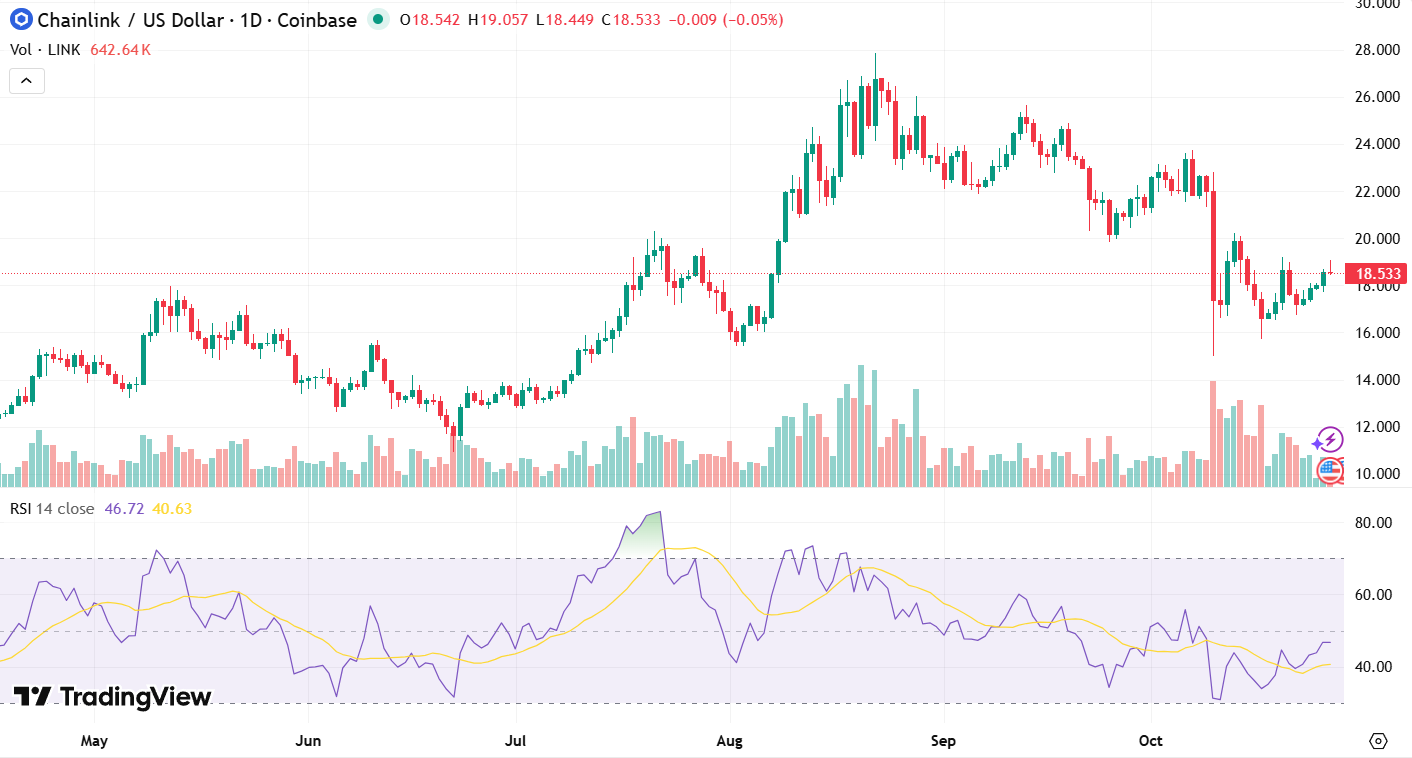
Conversely, diagnostics like the Money Flow Index (MFI) and Chaikin Money Flow (CMF) are showing signs of life, hinting at growing accumulation from larger holders. Combine this with a potentially dovish Fed decision, and Chainlink could be gearing for something special.

2. Dogecoin (DOGE)
Dogecoin enters the FOMC event with a bit of range-bound suspense. Since October 11, DOGE has been oscillating between $0.17 and $0.20, waiting for a trigger. A clean breakout above $0.21 could open the door to a move back towards $0.27, especially if risk-on sentiment returns.
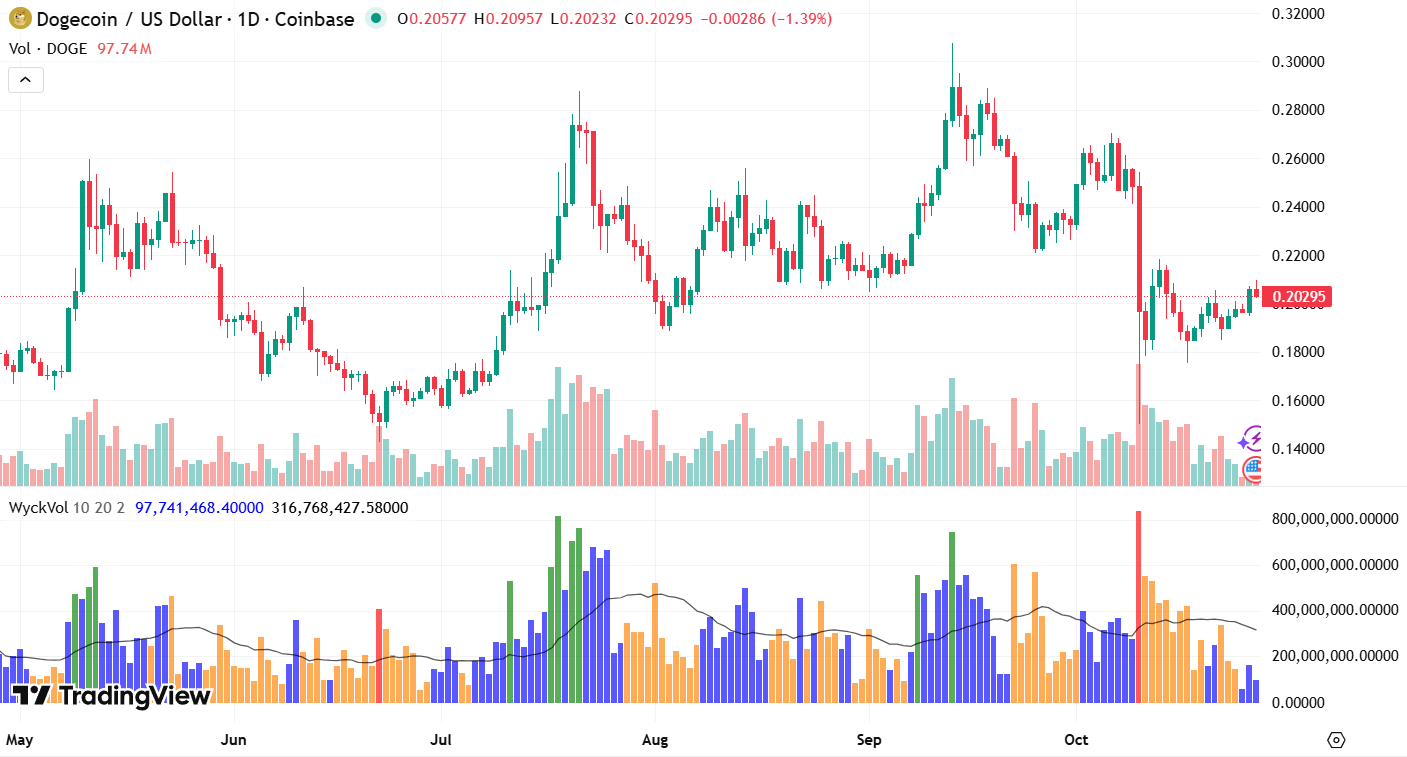
Volume and whale‐level data add texture to the setup. The Wyckoff volume profile recently flipped from seller control to buyer control, suggesting strategic accumulation may be underway. DOGE may be quieting down before a move, a scenario traders should keep front of mind as the Fed’s decision could stir things.
3. Uniswap (UNI)
Uniswap offers compelling recovery stories entering the FOMC session. The token experienced a sharp drop on October 10, with the RSI falling below 30, classic oversold territory. Since then, UNI has rallied from near $6.20 toward $6.50, supported by strong volume on the breakout. Holding above $6.40 may confirm that buying interest is sustained.

For longer-term watchers, UNI’s former highs at $12.15 in August and $18.71 in December set the stage for what could become a multi-leg recovery if macro conditions cooperate. In a market where liquidity expectations hinge on the Fed, Uniswap's rebound has the potential to accelerate, particularly if altcoin capital begins rotating into DeFi infrastructure.
The Verdict
These tokens aren't just compelling because of their individual fundamentals, it's how those fundamentals intersect with the current macro picture. With markets rebounding and rate cuts looking increasingly likely, crypto stands to gain. Lower rates typically fuel risk appetite, unlock liquidity, and drive capital toward speculative plays, creating tailwinds that can supercharge momentum in well positioned altcoins.
That said, the Fed could also surprise with restraint, and even another “standard” 25-basis-point cut may be viewed as lukewarm. In such scenarios, the dollar may strengthen and risk assets could wobble. Traders and investors should therefore approach the market with discipline, track the macro context, and be prepared for either direction.

Why can't a fully compliant, regulated crypto business secure a bank account in 2025?
If you're operating in this space, you already know the answer. You've lived through it. You've submitted the documentation, walked through your AML procedures, and demonstrated your regulatory compliance… only to be rejected. Or worse still, waking up to find your existing account frozen, with no real explanation and no path forward.
This isn't about isolated cases or bad actors being weeded out. It's a pattern of systematic risk aversion that's creating real barriers to growth across the entire sector, and it's throttling one of the most significant financial innovations of our generation.
We're Tap, and we're building the infrastructure that traditional banks refuse to provide.
The Economics Behind the Blockade
Let's examine what's actually driving this exclusion, because it's rarely about the reasons banks cite publicly.
The European Banking Authority has explicitly warned against unwarranted de-risking, noting it causes "severe consequences" and financial exclusion of legitimate customers. Yet the practice continues, driven by two fundamental economic pressures that have nothing to do with your business's actual risk profile.
The compliance cost calculation
Financial crime compliance across EMEA costs organizations approximately $85 billion annually. For traditional banks, the math is simple: serving crypto businesses requires specialized expertise, enhanced monitoring, and ongoing due diligence. As a result, it's cheaper to reject the entire sector than to build the infrastructure needed to serve it properly.
The regulatory capital burden
New EU regulations impose a 1,250% risk weight on unbacked crypto assets such as Bitcoin and Ethereum. This isn't a compliance requirement; it's a capital penalty that makes crypto exposure commercially unviable for traditional institutions, regardless of the actual risk individual clients present.
In the UK, approximately 90% of crypto firm registration applications have been rejected or withdrawn, often citing inadequate AML controls. Whether those assessments are accurate or not, they've created the perfect justification for blanket rejection policies.
The result? Compliant businesses are being treated the same as bad actors; not because of what they've done, but because of the sector they're in.
The Real Cost of Financial Exclusion
Financial exclusion isn’t just an hiccup; it creates tangible operational barriers that ripple through every part of running a crypto business.
Firms that have secured MiCA authorization, built robust compliance programs, and met regulatory requirements can find themselves locked out of basic banking services. Essential fiat on-ramps and off-ramps remain inaccessible, slowing payments, limiting growth, and complicating cash flow management.
Individual cases illustrate the problem vividly as well. Accounts are closed because a business receives a payment from a regulated exchange. Others are dropped with vague references to “commercial decisions,” offering no substantive justification. Founders frequently struggle to separate personal and business finances, as both are considered too risky to serve.
The irony is striking. By refusing service to compliant businesses, traditional banks aren’t mitigating risk; they’re amplifying it. Forced to operate through less regulated channels, these legitimate firms face higher operational and compliance risks, slower transactions, and reduced investor confidence. Over time, this slows innovation, and raises the cost of doing business for firms that are legally and technically sound.
Debanking Beyond Europe: U.S. Crypto Firms Face Their Own Challenges
Limited access to banking services isn’t exclusive to Europe. Leading firms in the U.S. crypto industry have faced numerous challenges regarding the banking blockade. Alex Konanykhin, CEO of Unicoin, described repeated account closures by major banks such as Citi, JPMorgan, and Wells Fargo, noting that access was cut off without explanation. Unicoin’s experience echoes a broader sentiment among crypto executives who argue that traditional financial institutions remain wary of digital asset businesses despite recent policy shifts toward a more pro-innovation stance.
Jesse Powell, co-founder of Kraken, has also spoken out about being dropped by long-time banking partners, calling the practice “financial censorship in disguise.” Caitlin Long, founder of Custodia Bank, recounted how her institution was repeatedly denied services. Gemini founders Tyler Winklevoss and Cameron Winklevoss shared similar frustrations.
These experiences reveal a pattern many in the industry interpret as systemic risk aversion. Even in a market as large and mature as the United States, crypto-focused businesses continue to encounter obstacles in maintaining basic financial infrastructure. The issue became especially acute after the collapse of crypto-friendly banks such as Silvergate, Signature, and Moonstone; institutions that once served as key bridges between fiat and digital assets. Their exit left a gap few traditional players have been willing to fill.
Why Tap Exists
The crypto industry has reached an inflection point. Regulatory frameworks like MiCA are providing clarity. Institutional adoption is accelerating. The technology is proven and tested. But the fundamental infrastructure gap remains: access to business banking that actually works for digital asset businesses.
This is precisely why we built Tap for Business.
We provide business accounts with dedicated EUR and GBP IBANs specifically designed for crypto companies and businesses that interact with digital assets. This isn't a side offering or an experiment, it's our core focus.
Our approach is straightforward
We built our infrastructure for this sector
Rather than retrofitting traditional banking systems to reluctantly accommodate crypto businesses, we designed our compliance, monitoring, and operational frameworks specifically for digital asset flows. This means we can properly assess and serve businesses that others automatically reject.
We price in the actual risk, not the sector
Blanket rejection policies exist because they're cheap and simple. We take a different approach: evaluating each business based on their actual controls, compliance posture, and operational reality. It costs more, but it's the only way to serve this market properly.
We're committed to sector normalization
Every time a legitimate crypto business is forced to operate without proper banking infrastructure, it reinforces outdated stigmas. By providing professional financial services to compliant businesses, we're helping demonstrate what should be obvious: crypto companies can and should be served by the financial system.
It isn't about taking on risks that others won't. It's about properly evaluating risks that others refuse to understand.
Moving Forward
The industry is maturing. Regulatory clarity is emerging. Institutional adoption is accelerating. But you can't put your business on hold while traditional banks slowly catch up to reality.
That's not sustainable in the long run.
As a firm, you shouldn't have to beg for a bank account. You shouldn't have to downplay your crypto operations just to access basic financial services. And you certainly shouldn't have to accept that systematic exclusion with little to no explanation other than “It’s just how things are."
The crypto sector is building the future of finance. Your banking partner should believe in that future too. If you're ready to work with financial infrastructure built for your business, not in spite of it, here we are.
Talk today with one of our experts to understand how we can help your business access the banking infrastructure you need.

Το Tether, ένα από τα κορυφαία 5 κρυπτονομίσματα, έχει προκαλέσει έντονες συζητήσεις στον χώρο των κρυπτονομισμάτων και παραμένει το αγαπημένο stablecoin στην αγορά. Με συχνά τον μεγαλύτερο ημερήσιο όγκο συναλλαγών, το Tether έχει καθιερωθεί ως αναπόσπαστο κομμάτι της βιομηχανίας κρυπτονομισμάτων. Ας αναλύσουμε περισσότερα για το ψηφιακό νόμισμα Tether.
Από την εμφάνιση του ψηφιακού χρήματος, η χρήση του έχει αυξηθεί σημαντικά, αλλά έχει συνοδευτεί και από ανησυχίες σχετικά με τους κινδύνους που ενέχει. Ενώ οι παραδοσιακοί επενδυτές συχνά επικρίνουν τη μεταβλητότητα των αγορών κρυπτονομισμάτων, πολλές κοινότητες σε όλο τον κόσμο έχουν για πρώτη φορά πρόσβαση σε χρηματοοικονομικές υπηρεσίες, απαιτώντας μόνο σύνδεση στο διαδίκτυο, χωρίς την ανάγκη για χρονοβόρες διαδικασίες ανοίγματος τραπεζικών λογαριασμών.
Όταν μιλάμε για την ασφάλεια και τη διαφάνεια που μπορούν να παρέχουν τα ψηφιακά νομίσματα, αυτά αντιμετωπίζουν άμεσα προβλήματα που εμφανίζονται συχνά στις παραδοσιακές αγορές νομισμάτων. Παρόλο που πολλοί θεωρούν το Bitcoin και τα κρυπτονομίσματα γενικότερα ως "επικίνδυνα" ή "φούσκες", η αλήθεια είναι ότι αυτές οι νέες υπηρεσίες πληρωμών έχουν φέρει πολυάριθμα αποτελέσματα σε ένα παρωχημένο σύστημα.
Τι είναι το Tether (USDT);
Το Tether (USDT) είναι ένα κρυπτονόμισμα συνδεδεμένο με το δολάριο ΗΠΑ, γνωστό και ως stablecoin. Τα stablecoins διατηρούν την αξία του νομίσματος ή του εμπορεύματος με το οποίο είναι συνδεδεμένα σε αναλογία 1:1. Το Tether είναι το πρώτο stablecoin στον κόσμο, που λανσαρίστηκε αρχικά για συναλλαγές το 2014 με την ονομασία Realcoin.
Αν και το Tether λανσαρίστηκε αρχικά στο Omni Layer του blockchain του Bitcoin, πλέον είναι συμβατό με διάφορα άλλα blockchains, όπως Ethereum, TRON, EOS, Algorand, Solana και το OMG Network.
Ένα stablecoin απαιτεί η κυκλοφορούσα προσφορά του να αντιστοιχείται από κεφάλαια αποθηκευμένα σε λογαριασμό αποθεματικού. Το Tether χρησιμοποιεί έναν συνδυασμό εμπορικών χρεογράφων, καταθέσεων, μετρητών, συμφωνιών επαναγοράς και ομολόγων του Δημοσίου για να διατηρήσει την κυκλοφορούσα αξία. Παρά τις φήμες για την επάρκεια των αποθεμάτων του Tether, η δημοτικότητα και η αγοραστική του δύναμη συνεχίζουν να αυξάνονται.
Ο βασικός στόχος του Tether είναι να παρέχει ένα ψηφιακό περιουσιακό στοιχείο με σταθερή τιμή αγοράς, το οποίο αξιοποιεί τη δύναμη της τεχνολογίας blockchain και τα οφέλη των κρυπτονομισμάτων χωρίς να υφίσταται τη μεταβλητότητα που τα χαρακτηρίζει. Μπορείτε να επισκεφθείτε τον ιστότοπο του Tether για μια πιο λεπτομερή κατανόηση των χαρακτηριστικών του νομίσματος.
Ποια είναι η αξία του Tether;
Ενώ τα περισσότερα κρυπτονομίσματα αποκτούν αξία από την προσφορά και τη ζήτηση, τα stablecoins είναι συνδεδεμένα με ένα νόμισμα ή ένα εμπόρευμα. Αυτό σημαίνει ότι η αξία τους παραμένει σταθερή και συνδέεται άμεσα με την αξία του νομίσματος ή του εμπορεύματος που αντιπροσωπεύουν, συνήθως σε αναλογία 1:1.
Στην περίπτωση του Tether, η αξία του αντανακλά πάντα την αξία ενός δολαρίου ΗΠΑ. Αν και η αξία παραμένει αμετάβλητη, είναι σημαντικό να σημειωθεί ότι το stablecoin έχει καταφέρει να γίνει ένα από τα πιο διαπραγματεύσιμα κρυπτονομίσματα στην αγορά.
Ποιοι δημιούργησαν το Tether;
Όπως αναφέρθηκε, το Tether αρχικά ονομαζόταν Realcoin όταν λανσαρίστηκε το 2014 και δημιουργήθηκε από τον επενδυτή Bitcoin Brock Pierce, τον επιχειρηματία Reeve Collins και τον προγραμματιστή λογισμικού Craig Sellars. Αργότερα μετονομάστηκε σε USTether και τελικά πήρε το όνομα USDT.
Οι τρεις συνιδρυτές έχουν βαθιά εμπειρία στον τομέα των κρυπτονομισμάτων, ενώ όλοι έχουν συνιδρύσει και συμμετάσχει ενεργά σε διάφορα έργα σχετικά με blockchain και κρυπτονομίσματα.
Η εταιρεία έχει επίσης δημιουργήσει μια σειρά από άλλα stablecoins που λύνουν το πρόβλημα της μεταβλητότητας σε πολλές αγορές, συμπεριλαμβανομένου του Tether συνδεδεμένου με το ευρώ (EURT), του Tether συνδεδεμένου με το κινέζικο γουάν (CNHT) και του Tether συνδεδεμένου με τον χρυσό (XAUT).
Πώς Λειτουργεί το Tether;
Το Tether δεν διαθέτει δικό του blockchain για τη λειτουργία του. Αντίθετα, λειτουργεί ως ένα token δεύτερου επιπέδου πάνω σε ήδη καθιερωμένα blockchains, όπως το Bitcoin, το Ethereum, το EOS, το Tron, το Algorand, το Bitcoin Cash και το OMG.
Παρόλα αυτά, το Tether λειτουργεί όπως κάθε άλλο κρυπτονόμισμα, αποθηκεύεται και διαχειρίζεται μέσω wallets που είναι συμβατά με το blockchain στο οποίο έχει δημιουργηθεί. Σημειώστε ότι δεν μπορείτε να στείλετε USDT που βασίζεται στο Ethereum blockchain σε ένα wallet που βασίζεται στο Tron, καθώς πρέπει να παραμείνει στο αντίστοιχο blockchain. Το αποτέλεσμα μιας τέτοιας ενέργειας θα ήταν η απώλεια των νομισμάτων.
Η κυκλοφορούσα προσφορά του Tether απαιτείται να υποστηρίζεται πάντα από τον ίδιο αριθμό δολαρίων ΗΠΑ που διατηρούνται σε λογαριασμό αποθεματικού. Αυτά τα αποθέματα μπορούν επίσης να περιλαμβάνουν άλλα ισοδύναμα μετρητά, περιουσιακά στοιχεία και απαιτήσεις από δάνεια.
Παρέχοντας ένα σταθερό ψηφιακό νόμισμα σε μια κατά τα άλλα σχετικά ασταθή αγορά, το Tether επιτρέπει στους χρήστες να πραγματοποιούν συναλλαγές σε USD, τόσο διεθνώς όσο και τοπικά, χωρίς ανησυχίες για διακυμάνσεις τιμών. Επιπλέον, προσφέρει πολύτιμη προστασία σε αγορές που αντιμετωπίζουν ξαφνικές ή δραματικές πτώσεις τιμών.
Τι Είναι το USDT;
Το USDT είναι ένα stablecoin συνδεδεμένο με το δολάριο ΗΠΑ σε αναλογία 1:1. Δημιουργημένο υπό την επωνυμία Tether, το USDT είναι το πιο ευρέως χρησιμοποιούμενο stablecoin στην αγορά σήμερα. Υπάρχει θεωρητικά απεριόριστη προσφορά USDT, με περίπου 72,5 δισεκατομμύρια σε κυκλοφορία τη στιγμή της σύνταξης αυτού του άρθρου.
Το USDT προσφέρει ένα ασφαλές καταφύγιο για τους επενδυτές όταν οι αγορές υφίστανται σημαντικές πτωτικές τάσεις τιμών, προσφέροντας μια σταθερή αξία για τη μεταφορά των κεφαλαίων, χωρίς να απαιτείται ρευστοποίηση των ψηφιακών περιουσιακών στοιχείων σε μετρητά.
Πώς Μπορώ να Αγοράσω USDT;
Αν επιθυμείτε να εντάξετε το Tether (USDT) στο crypto χαρτοφυλάκιό σας, μπορείτε να το κάνετε εύκολα μέσω της εφαρμογής Tap για κινητά. Μετά την ολοκλήρωση μιας απλής διαδικασίας επαλήθευσης KYC, οι χρήστες αποκτούν πρόσβαση σε μια σειρά από αγορές κρυπτονομισμάτων και μπορούν να αποθηκεύσουν τα ψηφιακά περιουσιακά στοιχεία στα μοναδικά, ενσωματωμένα crypto wallets μας.
Η δυναμική του blockchain και των κρυπτονομισμάτων είναι τεράστια. Με τη βοήθεια της εφαρμογής Tap, μπορείτε να διαχειρίζεστε το crypto χαρτοφυλάκιό σας και τα fiat κεφάλαιά σας εν κινήσει, ενώ παράλληλα επωφελείστε από πραγματικές χρήσεις, όπως η Tap προπληρωμένη κάρτα, που παρέχει πρόσβαση σε πληρωμές σε περισσότερους από 40 εκατομμύρια εμπόρους παγκοσμίως.
Αποποίηση Ευθύνης
Αυτό το άρθρο προορίζεται αποκλειστικά για γενικούς ενημερωτικούς σκοπούς και δεν αποτελεί νομική, οικονομική ή άλλη επαγγελματική συμβουλή ή σύσταση οποιουδήποτε είδους και δεν πρέπει να θεωρείται ή να αντιμετωπίζεται ως υποκατάστατο για συγκεκριμένες συμβουλές που σχετίζονται με συγκεκριμένες περιστάσεις.
Δεν παρέχουμε καμία εγγύηση, δήλωση ή υπόσχεση σχετικά με το περιεχόμενο αυτού του άρθρου (συμπεριλαμβανομένων, ενδεικτικά, της ποιότητας, ακρίβειας, πληρότητας ή καταλληλότητας του περιεχομένου για οποιονδήποτε σκοπό) ή οποιοδήποτε άλλο περιεχόμενο που αναφέρεται ή αποκτάται μέσω υπερσυνδέσμων αυτού του άρθρου. Δεν παρέχουμε δηλώσεις, εγγυήσεις ή διαβεβαιώσεις, είτε ρητές είτε σιωπηρές, ότι το περιεχόμενο στον ιστότοπό μας είναι ακριβές, πλήρες ή ενημερωμένο.
TAP'S NEWS AND UPDATES
What’s a Rich Text element?
What’s a Rich Text element?The rich text element allows you to create and format headings, paragraphs, blockquotes, images, and video all in one place instead of having to add and format them individually. Just double-click and easily create content.
The rich text element allows you to create and format headings, paragraphs, blockquotes, images, and video all in one place instead of having to add and format them individually. Just double-click and easily create content.Static and dynamic content editing
Static and dynamic content editingA rich text element can be used with static or dynamic content. For static content, just drop it into any page and begin editing. For dynamic content, add a rich text field to any collection and then connect a rich text element to that field in the settings panel. Voila!
A rich text element can be used with static or dynamic content. For static content, just drop it into any page and begin editing. For dynamic content, add a rich text field to any collection and then connect a rich text element to that field in the settings panel. Voila!How to customize formatting for each rich text
How to customize formatting for each rich textHeadings, paragraphs, blockquotes, figures, images, and figure captions can all be styled after a class is added to the rich text element using the "When inside of" nested selector system.
Headings, paragraphs, blockquotes, figures, images, and figure captions can all be styled after a class is added to the rich text element using the "When inside of" nested selector system.What’s a Rich Text element?
What’s a Rich Text element?The rich text element allows you to create and format headings, paragraphs, blockquotes, images, and video all in one place instead of having to add and format them individually. Just double-click and easily create content.
The rich text element allows you to create and format headings, paragraphs, blockquotes, images, and video all in one place instead of having to add and format them individually. Just double-click and easily create content.Static and dynamic content editing
Static and dynamic content editingA rich text element can be used with static or dynamic content. For static content, just drop it into any page and begin editing. For dynamic content, add a rich text field to any collection and then connect a rich text element to that field in the settings panel. Voila!
A rich text element can be used with static or dynamic content. For static content, just drop it into any page and begin editing. For dynamic content, add a rich text field to any collection and then connect a rich text element to that field in the settings panel. Voila!How to customize formatting for each rich text
How to customize formatting for each rich textHeadings, paragraphs, blockquotes, figures, images, and figure captions can all be styled after a class is added to the rich text element using the "When inside of" nested selector system.
Headings, paragraphs, blockquotes, figures, images, and figure captions can all be styled after a class is added to the rich text element using the "When inside of" nested selector system.What’s a Rich Text element?
What’s a Rich Text element?The rich text element allows you to create and format headings, paragraphs, blockquotes, images, and video all in one place instead of having to add and format them individually. Just double-click and easily create content.
The rich text element allows you to create and format headings, paragraphs, blockquotes, images, and video all in one place instead of having to add and format them individually. Just double-click and easily create content.Static and dynamic content editing
Static and dynamic content editingA rich text element can be used with static or dynamic content. For static content, just drop it into any page and begin editing. For dynamic content, add a rich text field to any collection and then connect a rich text element to that field in the settings panel. Voila!
A rich text element can be used with static or dynamic content. For static content, just drop it into any page and begin editing. For dynamic content, add a rich text field to any collection and then connect a rich text element to that field in the settings panel. Voila!How to customize formatting for each rich text
How to customize formatting for each rich textHeadings, paragraphs, blockquotes, figures, images, and figure captions can all be styled after a class is added to the rich text element using the "When inside of" nested selector system.
Headings, paragraphs, blockquotes, figures, images, and figure captions can all be styled after a class is added to the rich text element using the "When inside of" nested selector system.
Say goodbye to low-balance stress! Auto Top-Up keeps your Tap card always ready, automatically topping up with fiat or crypto. Set it once, and you're good to go!
Read moreWhat’s a Rich Text element?
What’s a Rich Text element?The rich text element allows you to create and format headings, paragraphs, blockquotes, images, and video all in one place instead of having to add and format them individually. Just double-click and easily create content.
The rich text element allows you to create and format headings, paragraphs, blockquotes, images, and video all in one place instead of having to add and format them individually. Just double-click and easily create content.Static and dynamic content editing
Static and dynamic content editingA rich text element can be used with static or dynamic content. For static content, just drop it into any page and begin editing. For dynamic content, add a rich text field to any collection and then connect a rich text element to that field in the settings panel. Voila!
A rich text element can be used with static or dynamic content. For static content, just drop it into any page and begin editing. For dynamic content, add a rich text field to any collection and then connect a rich text element to that field in the settings panel. Voila!How to customize formatting for each rich text
How to customize formatting for each rich textHeadings, paragraphs, blockquotes, figures, images, and figure captions can all be styled after a class is added to the rich text element using the "When inside of" nested selector system.
Headings, paragraphs, blockquotes, figures, images, and figure captions can all be styled after a class is added to the rich text element using the "When inside of" nested selector system.Έτοιμος για το πρώτο βήμα;
Γίνε μέρος της νέας γενιάς έξυπνων επενδυτών και όσων ξέρουν να διαχειρίζονται το χρήμα. Ξεκλείδωσε νέες δυνατότητες και ξεκίνα το δικό σου μονοπάτι προς την επιτυχία — σήμερα.
Ξεκίνα τώρα








